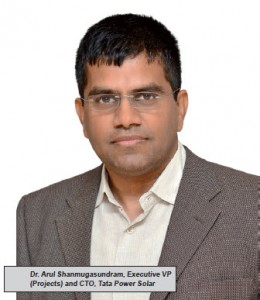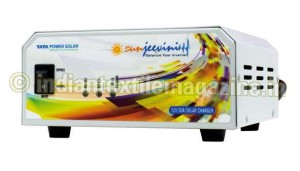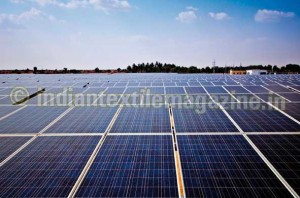The Indian Textile Industry has always been receptive in adapting to newer and more efficient technologies. Power has always been  anarea of concern and many textile mills have set-up captive power plants, wind mills and now Solar power plants. To tap this vast potential and to provide efficient and cost effective solutions, TATA Power Solar (TPS) has been working closely with the textile industry providing tailor made solutions based on customer requirements. The company has a dedicated team to service customers from the textile industry, says Mr. Gagan Pal, Vice President – Products, TPS. In a recent interview to The Textile Magazine, Mr. Gagan Pal spoke in detail on the solutions offered by TPS for the varying requirements of the industry.
anarea of concern and many textile mills have set-up captive power plants, wind mills and now Solar power plants. To tap this vast potential and to provide efficient and cost effective solutions, TATA Power Solar (TPS) has been working closely with the textile industry providing tailor made solutions based on customer requirements. The company has a dedicated team to service customers from the textile industry, says Mr. Gagan Pal, Vice President – Products, TPS. In a recent interview to The Textile Magazine, Mr. Gagan Pal spoke in detail on the solutions offered by TPS for the varying requirements of the industry.
Can you give a brief on Tata Power Solar and the products and solutions offered by the company?
Tata Power Solar (TPS), formerly known as Tata BP Solar, is an integrated solar solutions provider with more than 24 years of deep domain expertise in the Indian solar industry. Founded in 1989, the company was originally formed as a joint venture between Tata Power and British Petroleum Solar (BP Solar). As a pioneer and market leader in the solar space, TPS now operates independently as a wholly-owned subsidiary of Tata Power. Headquartered in Bangalore, TPS operates three manufacturing units there and has eight regional offices, 40 authorized service centres plus a network of more than 1,000 dealers and sub-dealers nationwide.
 As one of the largest solar manufacturers in India, TPS operates a state-of-the-art 200 MW module and 180 MW cell manufacturing facility in Bangalore. It has also completed more than 70 MW of ground-mount utility scale and 30 MW of rooftop projects across the country as of FY13. It also offers a diverse line of solar products for both urban and rural markets. These include water heaters, home lighting, street lighting, power packs, and water pumps among others. TPS is committed to enable solar everywhere and aims to provide energy access to millions of people across the country via its integrated solar solutions.
As one of the largest solar manufacturers in India, TPS operates a state-of-the-art 200 MW module and 180 MW cell manufacturing facility in Bangalore. It has also completed more than 70 MW of ground-mount utility scale and 30 MW of rooftop projects across the country as of FY13. It also offers a diverse line of solar products for both urban and rural markets. These include water heaters, home lighting, street lighting, power packs, and water pumps among others. TPS is committed to enable solar everywhere and aims to provide energy access to millions of people across the country via its integrated solar solutions.
With the gamut of solar products available with TPS energy requirements of various large-scale or small-scale industries such as manufacturing, healthcare, hospitality, IT/ITeS can be addressed.
What are the solutions offered by TPS specifically for the industrial segment, more particularly the textile industry?
TPS has executed several projects for the manufacturing & process industries such as food processing, automobiles, cable manufacturing, bottling plants, pharmaceuticals and cement. Being an energy company and having industry leading engineering expertise, TPS provides solutions for any conceivable need for power. For the power intensive textile industry, the company can provide solutions either on their roof top or on the ground. Solar power can be used at the spinning mills section – ring frame and open end spinning machines, knitting units, sizing mills, cording machines, etc. We have already done upto large MW scale of projects for the textile industry in Tamil Nadu.
For customers who want to use solar power but are not interested in making capex investments, TPS provides complete support through its revex partners an opex model. Customers have to sign the Power Purchase Agreement for installing solar power on their rooftops. Tata Power Solar also can offer revex models to its customers through its financial partners.
The rising energy cost has been a big concern for textile industry in India, particularly for units in the South. The power crisis has severely affected their operations and profitability. How can TPS save the industry from the crisis it is in?
The Indian textile industry is considered the second largest in the world. As we know, textile processing requires a lot of hot water in  the range of 40-110°C at various stages of the production process. Tata Power Solar can help generate the requisite heat through solar energy. We can help substitute conventional energy consumption with solar which will, in turn, result in huge monetary savings.
the range of 40-110°C at various stages of the production process. Tata Power Solar can help generate the requisite heat through solar energy. We can help substitute conventional energy consumption with solar which will, in turn, result in huge monetary savings.
For spinning mills the cost of power is a significant percentage of the conversion cost. It is important for spinning mill owners to make the investments to protect themselves from cost escalation in the long run. Typically spinning mills also have significant rooftop space that can be used to install several hundred KWp. Further, today the Government is supporting Accelerated Depreciation (AD) for solar projects. Combining AD and rooftop space for captive consumption and considering the displacement cost of power from the grid the investment will be paid off within five to six years, and subsequently you will be availing free power.
This access to lower cost power will make you more competitive in your conversion costs. Unlike wind power which is seasonal and relies heavily on banking which is subject to policy change, solar can provide uninterrupted power throughout the year. Further, installing it on the rooftop and connecting it at LT level you will have no Open Access charges, and the power generated will be truly yours.
If you look at the power sector, grid power is increasing at six per cent with an increase in DG usage and power cuts, particularly during the no-wind months. Return on the invested money can be faster if you are displacing diesel power costs. While there is an additional potential regulatory driver in Solar Purchase Obligations in Tamil Nadu, our view is that independent of this obligation it makes sense for textile industry owners to pursue solar. This is the best way for them to protect themselves from future power cost escalations and develop a long-term differentiator for their businesses and future generations.
To achieve this, textile companies are now coming forward to use the area available on their roof-tops to install solar PV plants. While there is considerable amount of initial investment required for setting up the plant, its running cost is for less. With the life of the power plant >25 years and operating expenses at around one per cent, the generation cost outweighs the initial investment in quick time. Availability of AD makes solar investment more economical and gives power independence to customers. The payback period for the solar plant with AD considered is around three years, which is considered one of the best investments for a product with a life time of 25 years.
With power generated right on their rooftop, the loss of transmission and distribution are also completely eliminated.
How important is the textile industry as a vertical for TPS? Can you name some of the key installations made by TPS in textile manufacturing units?
As we are all aware, textile industries are power intensive, and as such there is a gap in demand and supply of power to these industries. With the huge presence of textile companies in southern India and solar radiation available in abundance, solar power is definitely an alternate source of power for textile industries. TPS being a pioneer in providing solar power for more than two decades, we consider the textile industry as an important vertical within our company.
Seeing the response and the potential, we have a dedicated team within the company to service this vertical.
We have a range of MW installations completed and under execution for the textile industry, namely, Chennai Silk, both ground mounted and through open access, two MWp large rooftop projects for a spinning mill and many smaller rooftop projects for garment manufacturers.
The solar power as a segment is today crowded with many small and large-sized manufacturers, offering solutions at various price points. Why should a customer choose to go with your company? What is the technological advantage offered by TPS as compared to competitors?
Tata Power Solar is market leader in the solar industry and has successfully fulfilled the ‘Tata’ brand promise since inception. We are a fully integrated solar solutions provider and undertake the entire installation, servicing and maintenance of the project. We have partners who make the capital investments and sign the power purchase agreement (PPA) with the end customer and generate revenue based on the energy generated.
Till date, we have worked with corporates and successfully integrated solar solutions in large buildings which not only generate electricity but also function as a building component. We have been actively involved in providing EPC solutions to the grid-connected and off-grid market segments for the past 10 years. Our market reputation and the quality of our solutions are the decisive factors that lead our customer to choose our products & solutions over the competitors.
Tata Power Solar is the oldest company in this field in India with over 24 years of operational experience, over 500 MW of modules shipped globally, more than 200 MW of project experience, over 1000+ installations and 25 years of power generation warranty.
Our technological advantage over competition lies in our unmatched experience in designing, manufacturing and executing customized solar solutions for diverse sectors such as telecom, oil and gas, education, banking, healthcare, IT, public infrastructure like roads as well as railways.
Can you give a brief on your manufacturing capabilities, any recent investments and future expansion plans?
Tata Power Solar has a state-of-art 200 MW module and 180 MW cell manufacturing capacity. It plans to lead the solar modules manufacturing space in India. We have close to 100 MW of projects under various stages of completion, including the prestigious 50 MW solar power project for NTPC and the 28.8 MW project for Tata Power.
We will continue to work towards empowering people with solar-powered products that are innovative and cost-effective. Reducing cost and expanding coverage with the launch of a new portfolio of subsidy-free products like SunJeevini and Dynamo would also be one of our key focus areas going forward.
We are expanding our reach by augmenting our value-added resellers (VAR) in order to provide prompt pre- and post-sales support to our customers across India.
What are the future growth opportunities for solar power in India, and how do you see industries, particularly in the manufacturing segment, adapting to cleaner and greener fuel in the future?
India has a demand-supply gap of 12 per cent of its total energy demand and is in a state of perennial energy shortage. This trend is highly significant as the electricity segment is heavily dependent on coal and other non-renewable sources of energy. Renewable energy (RE) sources contribute only 7.7 per cent of the total installed power capacity. Hence, the solar energy potential in India is immense due to its convenient location near the Equator and also the growing power shortage in the country.
With growing awareness, we are witnessing large corporates and institutions adopting solar power.
Pioneering textile industrialists such as the Chennai Silks Group have recognized the long-term potential and the power security that Solar Power provides and have already begun their foray into solar investments on a continuing basis. In India, we have witnessed various businesses, non-profit and government organizations that have blanketed their rooftops and properties with photovoltaic solar installations to cut their own operating expenses. Hence, it can be deduced that solar power use is gaining momentum in India and is being used as a mainstream option for power generation.
Finally, why would you recommend solar power for industries like textile manufacturing?
First and foremost, it gives textile manufacturers control of one of the critical cost variables, power, and provides them a long-term differentiation. While as a percentage of conversion cost spinning mills have higher percentage, dyeing and fabric units will also benefit from its adoption. The early adopters of solar power who avail themselves of AD and REC benefits currently available would have built a long-term differentiator for their businesses and a winning proposition in the marketplace.
The grid power costs are likely to escalate at six per cent YoY and availability of grid power is also challenging, resulting in higher usage of diesel increasing overall energy costs. It is essential to have energy security for the future and also minimize the current diesel consumption costs leading to faster payback of the solar investment.
SunJeevini is a retrofit unit that allows conventional inverter batteries to be charged through solar power. Conventional inverter batteries do not serve their purpose very well in areas where there is constant power outage for considerable period of time. This one-of-a-kind unit will power an existing inverter battery with solar energy in the absence of grid power. SunJeevini can also be used to augment existing grid charging to save on electricity bills. This is a zero maintenance unit and can provide up to 3.5 hours of additional power back up in a day. SunJeevini is designed to be scalable from 80 to 600 solar peak watts without any major changes to the system.